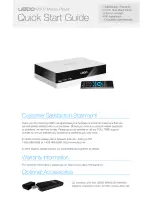
Switch on the IRD, the LCD will display the equipment type and current output stream as
shown on the following page,
Then pressing the “LOCK” key on the front p
3.2 General Setting
All options are available from these 9 root menu trees.
3.2.1 Input Setting
User can press “Enter” key to enter into the menu of the input setting.
3.2.1.1 Tuner In
Here we take 1.1 Tuner (DVB-S2) signal in as an example:
The page menu from 1.1 to 1.3 represents the tuner, ASI and IP input ports of the IRD.
User can multiplex the input programs from any port to output
programs at the same time. By pressing the
analyze the input TS or signal and then display the program list at the submenu, say,
1.1.1-1.1.6
►
1.1
1.2
1.3
H-HD-IRD
14
on the IRD, the LCD will display the equipment type and current output stream as
key on the front panel to enter to the main menu as below:
are available from these 9 root menu trees.
key to enter into the menu of the input setting.
S2) signal in as an example:
The page menu from 1.1 to 1.3 represents the tuner, ASI and IP input ports of the IRD.
User can multiplex the input programs from any port to output any program or all the
By pressing the “Enter” key, the device will take a while to
analyze the input TS or signal and then display the program list at the submenu, say,
DVB-S2 BTS HD IRD
Out Stream 00.006Mbps
►
1 Input Setting
2 Output Setting
3 Decoder Setting
4 Descramble Setting
5 Network Setting
6 Saving Configuration
7 Loading Configuration
8 Version (SNMP)
9 Language
1.1 Tuner (DVB-S2)
1.2 ASI
1.3 IP
IRD-V3 User Manual
on the IRD, the LCD will display the equipment type and current output stream as
anel to enter to the main menu as below:
The page menu from 1.1 to 1.3 represents the tuner, ASI and IP input ports of the IRD.
program or all the
key, the device will take a while to
analyze the input TS or signal and then display the program list at the submenu, say,








































